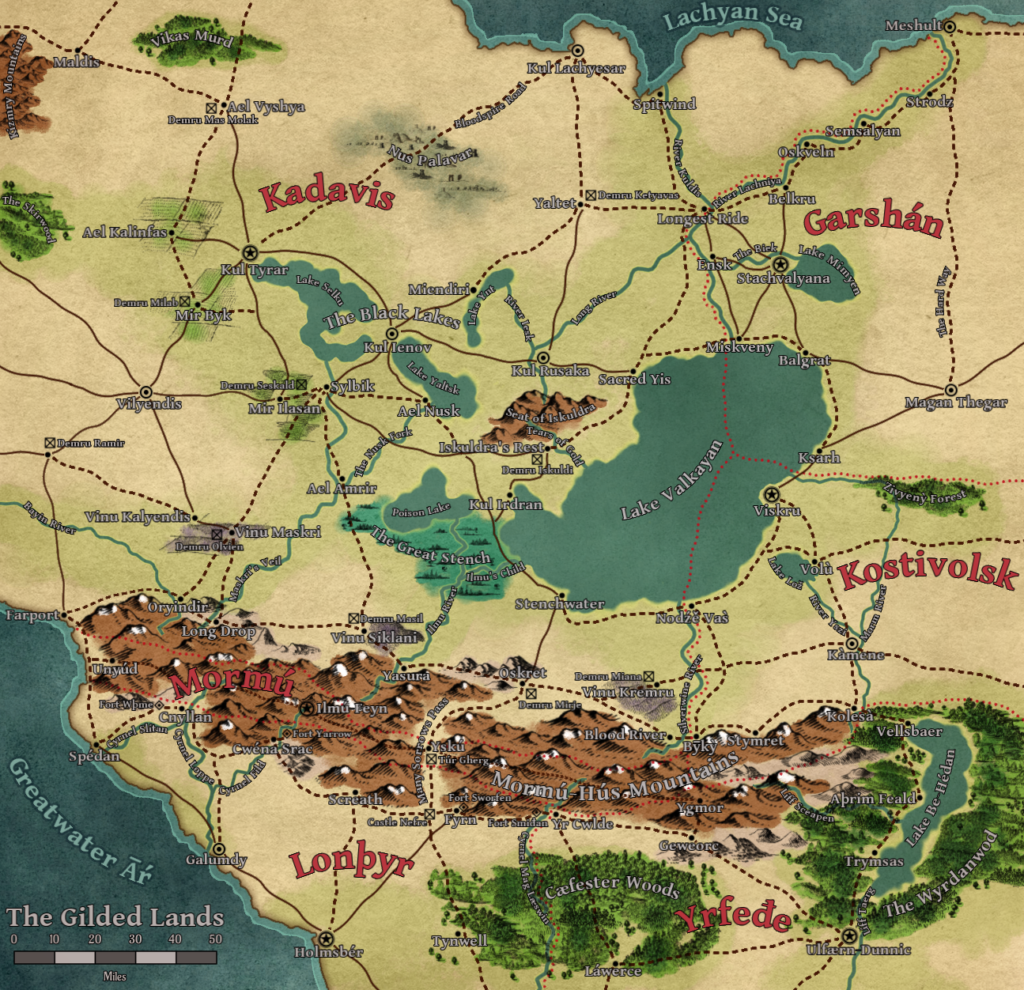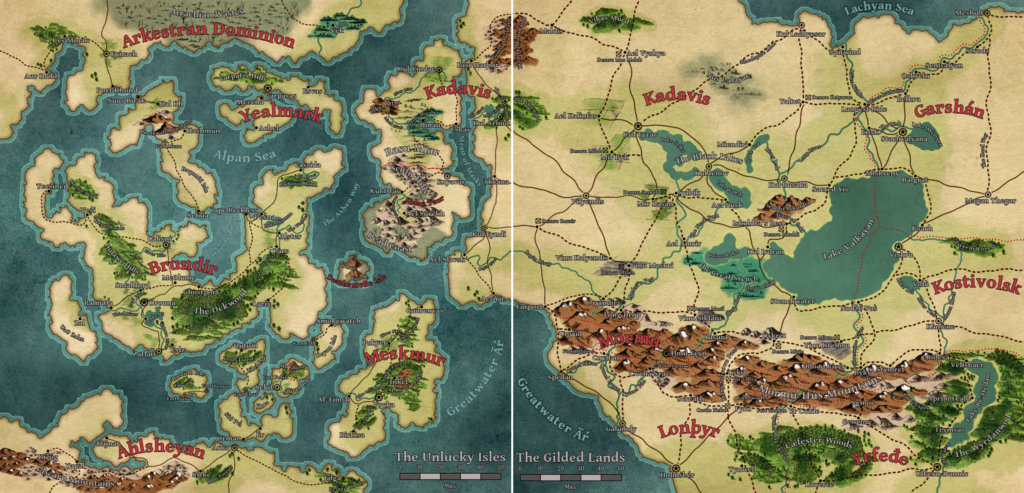Today I wrapped up my second region of Godsbarrow, the fantasy campaign setting I started working on earlier this year: the Gilded Lands, situated just to the east of my first region, the Unlucky Isles.

The Gilded Lands are anchored by Kadavis, the largest and wealthiest of the six nations that comprise this region. With its obsession with ostentatious displays of wealth and status, the near-universal cultural practice of wearing elaborate masks, and the magic-rich blight of Nus Palavar, the haunted graveyard of Kadavis’ small gods, decadent Kadavis has a swords and sorcery vibe to it.
The other nations of the Gilded Lands are quite different. Garshán is a land of gnomish traders who prize efficiency in all things. Many Sou gnomes also make their home here (albeit temporarily). In the south, expansionist Lonþyr plunders the Mormú-Hús Mountains and fights with its neighbor, Yrfeđe — once part of the same country. Yrfeđe is a dark place with a bit of a Norse vibe, defined by the predations of the seemingly unstoppable đargnr — the “sleeping shadows,” who emerge from the woods at night to feast.
Kostivolsk, a sinister halfling theocracy, keeps the đargnr on the other side of the border by sacrificing their own people to their oppressive deity, Xlě̀-Ceth. Centuries ago, the church began a ritual that has continued, unbroken, to the present day: Kosti dance or chant without cessation, until they drop dead. That endless sacrifice pays their god to shield Kostivolsk from the đargnr.
And at the center of it all is Mormú, the greatly diminished homeland of the Grshniki gnomes, and the source of much of the region’s wealth — most of which has been plundered by its neighbors. A pale shadow of its former glory, Mormú is divided over whether to give up and be absorbed by another nation, or continue their ceaseless guerilla war against the larger powers that they’ve waged for centuries.
Mapping and developing the Gilded Lands
This time around, I played a little looser with the Worlds Without Number steps — and having already done a whole series of step-by-step blog posts about creating the Unlucky Isles, I didn’t repeat that part of the process.
For the Gilded Lands, I started with the map. At any given stage of the WWN development process, my map was typically a step or two ahead. This was a fun approach, and it felt more organic. Whenever I was in the mood to draw, I worked on the map; when I wanted to write, I wrote.
I still consider the Unlucky Isles to be the default starting location for a Godsbarrow campaign (if there were ever to be a Godsbarrow campaign!), so I won’t be zooming in to detail out a smaller section of the Gilded Lands map just now. (For the Isles, I zoomed in on Sanχu, a province in Brundir.)
Here are the Gilded Lands and the Unlucky Isles together on one map (sorry about the seam!).

I did my best to get my two maps to line up, but from Wonderdraft’s perspective I’m doing this all backwards; I should be creating a continent-level map and then using the software to zoom in on regions. But I prefer this approach, where I’m letting my ideas flow and not hemming anything in about what’s outside my immediate area of focus.
For example, wanting to know more about Kadavis — which is on the eastern edge of the Unlucky Isles map — is what prompted me to work on the Gilded Lands. Feeling like there should be a big east-west “spray” of mountains in the Gilded Lands, and just going for it, is what gave rise to my favorite nation in that region: Mormú, the besieged, greatly diminished, fractious kingdom of the Grshniki gnomes, beset on all sides by hostile powers.
I’ve got a full region worth of write-ups to proofread and turn into blog posts — and while I work on that, I also need to get rolling on a third region! As with the Isles, the Gilded Lands feature multiple countries that extend off the regional map. These serve as anchors for adjacent maps, like Kadavis did for this one, and “seed the ground” for future development.
I don’t know where I’m headed next. After writing about the Gilded Lands a little bit every day for the past 10 weeks or so, my instinct is to shift my focus elsewhere — maybe explore Ahlsheyan and points south, or go north and figure out what’s going on around (and on) the Lachyan Sea.
(This post is one of a series about worldbuilding with Worlds Without Number.)
